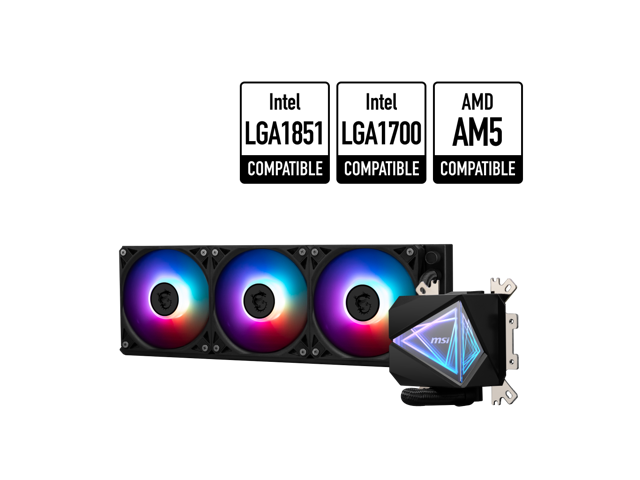
Introduction
MSI has been a staple in the PC component industry for as long as all of us can remember and over the course of the years, has been branching out from its motherboard roots into a full stack of products. We have looked at a number of their video cards, motherboards, SSDs, and power supplies, but today, we’ll take their new MAG CORELIQUID I360 AIO CPU cooler out for a spin to see if it continues their reputation for providing good products to gamers and creators.
We will again be using our second generation AIO test platform that is capable of putting out enough heat to make even the devil sweat. We do this to test AIO liquid cooling solutions that are likely to be used with some of today’s most demanding CPUs.
MSI MAG CORELIQUID I360 AIO CPU Cooler


The MSI MAG CORELIQUID I360 is an all-in-one (AIO) CPU cooler that is designed to work on a wide variety of sockets. These include Intel’s LGA 1700/115x/1200 and AMD’s AM5/AM4 sockets. Additionally, a “Next Gen” Intel socket is supported. We suspect will change to LGA 1851 in the documentation at some point in the future. Overall, the MSI MAG CORELIQUID I360 covers all current-day sockets by default but has dropped support for legacy Intel HEDT sockets such as 2011, 2013, 2066, etc as well as AMD sockets with a number lower than 4.


While we have the 360mm radiator version that we’re reviewing today, this AIO is also available with a 240mm radiator that sports a duo of 120mm fans. Due to the laws of thermodynamics, expect it to perform a little worse than the 360mm version we’re reviewing today.
We’re seeing a MSRP at the $139.99 price point for the 360mm radiator flavor and $109.99 for the 240mm flavor. Take a look at our shopping widgets for current pricing.
Water Block & Pump



The cold plate on the MSI MAG CORELIQUID I360 is made out of copper and is topped with a triangular dual-sided infinite mirror with the MSI logo on it. ARGB bling is also embedded that you can customize with your RGB controller. Of note, this is not a top that you can re-orient, so you’re limited to a single orientation option unless you really want it to be upside down.
The waterblock mounts using a UNI Bracket that will let you install it in both AMD and Intel systems without having to change the bracket.
The pump is PWM controlled with an approximate 3400 RPM (+/- 10%) speed at a 100% duty cycle. It pushes the water through 400mm of cooling hose to and from the radiator. MSI states the high efficiency pump leverages a three-phase motor for more efficient water-cooling operation.
Radiator


The liquid CPU cooler radiator is designed to hold three 120mm fans and measures 394x120x27mm. By our count, the aluminum radiator sports a density of 22 fins per inch and is attached to 400mm of tubing. MSI also includes a cable cover to assist with hiding the wires along the side.
Fans



The three included fans are 120mm fans. They feature loop dynamic bearings and RGB LEDs that can be controlled through the your favorite RGB application du jour. MSI lists a fan life expectancy of 30,000 hours at 40 degrees Celsius and a fan maximum speed of 2,350 RPM (+/- 10%), however, the minimum fan speed is not disclosed (we observed this to be a minimum of about 600RPM).
MSI does not list the expected decibels of noise production of the fan. The stated maximum airflow is 70.7 CFM with an unstated static pressure. Upon inspection of the fan labels, it appears that they are manufactured by Cooler Master. The fans are connected using a proprietary “EZ Connect” connector that makes it “EZ” to chain the fans together and use a single power and RGB cable to be run to your power source and RGB controller. On the downside, good luck finding a replacement fan if you need one.
Test Setup
We will use our second generation AIO test rig which we will publish further details on in the coming weeks. It is based on the Intel i9 13900K CPU running on an ASUS Z690-based motherboard. We will set up each cooler in the same manner with the radiator attached to the case and the fans blowing into the radiator. The water blocks will be mounted per the manufacturer’s instructions except that we will use Arctic Cooling MX-4 thermal paste. We will utilize ASUS FanXpert to control fan speeds, setting the fans at a fixed RPM for each test. We will also compare it to the other coolers we have tested thus far.
Installation



Installation of the MSI MAG CORELIQUID I360 was straight forward event and had us up and running fairly quickly. In general, everything plugs into the motherboard connectors and you can control them with the included software.




